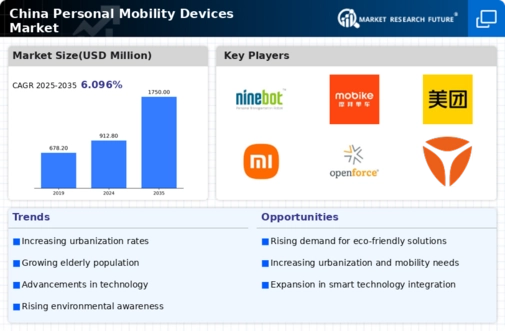Government Policies and Incentives
Government policies in China are significantly impacting the personal mobility-devices market. The Chinese government has introduced various incentives to promote the use of electric vehicles and personal mobility devices. Subsidies for electric scooters and bicycles, along with tax breaks for manufacturers, are designed to encourage adoption. Furthermore, the establishment of dedicated lanes and charging infrastructure supports the growth of this market. Recent initiatives indicate that the government aims to have 20% of all vehicles on the road be electric by 2025, which could substantially boost the personal mobility-devices market. These supportive measures create a favorable environment for both consumers and manufacturers, fostering innovation and growth.
Rising Urbanization and Population Density
The rapid urbanization in China is a crucial driver for the personal mobility-devices market. As cities expand and populations grow, the demand for efficient and compact transportation solutions intensifies. In urban areas, where traffic congestion is prevalent, personal mobility devices offer a practical alternative to traditional vehicles. The increasing population density in metropolitan regions, such as Beijing and Shanghai, necessitates innovative mobility solutions that can navigate crowded streets. According to recent data, urban areas in China are expected to house over 70% of the population by 2030, further propelling the need for personal mobility devices. This trend indicates a shift towards more sustainable and space-efficient modes of transport, which could reshape urban mobility dynamics significantly.
Technological Advancements in Mobility Solutions
Technological innovation plays a pivotal role in shaping the personal mobility-devices market. The integration of advanced technologies, such as IoT and AI, enhances the functionality and user experience of mobility devices. Smart features, including GPS navigation, app connectivity, and real-time tracking, are becoming increasingly common. These advancements not only improve safety but also provide users with greater convenience and efficiency. In China, the rise of smart cities is further driving the demand for technologically advanced personal mobility solutions. As consumers seek devices that offer enhanced connectivity and performance, the market is likely to witness a surge in demand for high-tech mobility devices, potentially leading to a more competitive landscape.
Shift in Consumer Preferences Towards Convenience
A notable shift in consumer preferences towards convenience is driving the personal mobility-devices market in China. As lifestyles become increasingly fast-paced, individuals are seeking transportation solutions that offer flexibility and ease of use. Personal mobility devices, such as e-scooters and electric bicycles, provide an efficient means of navigating urban environments without the hassles associated with traditional vehicles. Market data suggests that the demand for shared mobility services is also on the rise, with many consumers opting for rental options over ownership. This trend indicates a broader cultural shift towards convenience-oriented solutions, which could lead to a sustained increase in the adoption of personal mobility devices.
Environmental Awareness and Sustainability Initiatives
Growing environmental consciousness among Chinese consumers is significantly influencing the personal mobility-devices market. As awareness of air pollution and climate change rises, there is a marked shift towards eco-friendly transportation options. The Chinese government has implemented various sustainability initiatives aimed at reducing carbon emissions, which aligns with the increasing adoption of electric and non-motorized mobility devices. Reports suggest that the market for electric scooters and bicycles is projected to grow at a CAGR of approximately 15% over the next five years. This shift not only reflects consumer preferences but also indicates a broader societal movement towards sustainable living, thereby enhancing the appeal of personal mobility devices.

















Leave a Comment